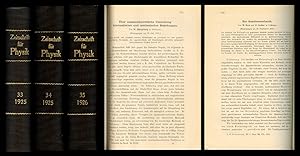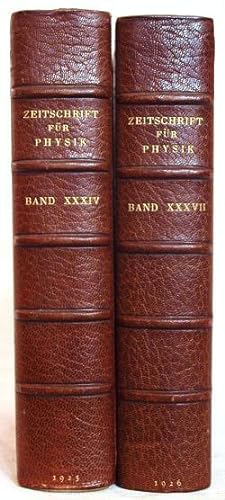Heisenberg, Werner; Born, Max; Jordan, Pasqual (4 results)
Product Type
- All Product Types
- Books (4)
- Magazines & Periodicals
- Comics
- Sheet Music
- Art, Prints & Posters
- Photographs
- Maps
-
Manuscripts &
Paper Collectibles
Condition
- All Conditions
- New
- Used
Binding
- All Bindings
- Hardcover (1)
- Softcover
Collectible Attributes
- First Edition (2)
- Signed
- Dust Jacket
- Seller-Supplied Images
- Not Printed On Demand
Seller Location
Seller Rating
-
Uber quantentheoretische Umdeutung kinematischer und mechanischer Beziehungen in Zeitschrift fur Physik, 33, 1925, pp. 879 to 893. WITH: Born and Jordan Zur Quantenmechanik in Zeitschrift fur Physik, 34, 1925, pp. 858 to 888. WITH: Born, Heisenberg and Jordan Zur Quantenmechanik II in Zeitschrift für Physik, 35, 1926, pp.557 to 615
Published by Julius Springer, Berlin
Seller: Atticus Rare Books, West Branch, IA, U.S.A.
First Edition
1st Edition. FIRST EDITIONS OF THREE LANDMARK PAPERS THAT TOGETHER FORMED THE THEORETICAL FOUNDATION OF QUANTUM MECHANICS. "In spite of its high-sounding name and its successful solutions of numerous problems in atomic physics, quantum theory, and especially the quantum theory of polyelectronic systems, prior to 1925, was, from the methodological point of view, a lamentable hodgepodge of hypotheses, principles, theorems, and computational recipes rather than a logical consistent theory. Every single quantum-theoretic problem had to be solved first in terms of classical physics; its classical solution had then to pass through the mysterious sieve of the quantum conditions or, as it happened in the majority of cases, the classical solution had to be translated into the language of quanta in conformance with the correspondence principle. In short, quantum theory still lacked two essential characteristics of a full-fledged scientific theory, conceptual autonomy and logical consistency" (Jammer, The Conceptual Development 196). The work of Heisenberg, Born, and Jordan in these papers began to rectify these issues and together marked the "starting point for the new quantum mechanics," also called matrix mechanics (DSB). "In May 1925, Heisenberg took on a new and difficult problem, the calculation of the line intensities of the hydrogen spectrum. Just as he had done with Kramers and Bohr, Heisenberg began with a Fourier analysis of the electron orbits. When the hydrogen orbit proved too difficult, he turned to the an harmonic oscillator. With a new multiplication rule relating the amplitudes and frequencies of the Fourier components to observed quantities, Heisenberg succeeded in quantizing the equations of motion for this system in close analogy with the classical equations of motion. In June Heisenberg returned to Göttingen, where he drafted his fundamental paper [the 1st paper], which he completed in July. In this paper Heisenberg proclaimed that the quantum mechanics of atoms should contain only relations between experimentally observable quantities. The resulting formalism served as the starting point for the new quantum mechanics, based, as Heisenberg's multiplication rule implied, on the manipulation of ordered sets of data forming a mathematical matrix. Born and his assistant, Pascual Jordan, quickly developed the mathematical content of Heisenberg's work into a consistent theory with the help of abstract matrix algebra [the 2nd paper].Their work, in collaboration with Heisenberg, culminated in their "three-man paper" ["Dreimännerarbeit", the 3rd paper] that served as the foundation of matrix mechanics. Confident of the correctness of the new theory, Heisenberg, Pauli, Born, Dirac, and others began applying the difficult mathematical formalism to the solution of lingering problems" (DSB). ALSO INCLUDED in ZfP Volume 33 is a major milestone in gravitational wave theory: the Czech physicist Guido Beck's discovery of a family of exact solutions to the equations of general relativity representing gravitational waves with cylindrical symmetry (called 'Beck vacua' or 'cylindrical gravitational waves'). His paper, "Zur Theorie Binärer Gravitationsfelder" appears on pp. 713-738. ALSO: We offer the Heisenberg paper (Volume 33) as a lone offering. Heisenberg, Werner "Über quantentheoretische Umdeutung kinematischer und mechanischer Beziehungen" in ZfP 33, 1925, pp. 879-893. ALSO, we offer Pauli's 1926 paper with the 1st significant application of & 1st validation of Heisenberg's new quantum mechanics. ("Über das Wasserstoffspektrum vom Standpunkt der neuen Quantenmechanik" in ZfP 36, 1926). CONDITION & DETAILS: In: ZfP 33 (1925), 34 (1925), 35 (1926). 8vo. (225 x 156mm). 3 full volumes. Volume 33 has no ex-libris stamps whatsoever; volumes 34 and 35 have some on the title page. Handsomely and uniformly rebound in grey linen, gilt-tooled and lettered at the spine. Tightly bound. Very clean inside and out. Near fine condition.
-
Zeitschrift Fur Physik. Band 34. September-November 1925.; Zeitschrift Fur Physik. Band 37. May-July 1926
Published by Berlin : J. Springer, 1925
Book
Hardcover. Condition: Very Good. 2 Volumes. Band 34 and 37. Bound in modern 3/4 crushed red Moroccan leather. Red cloth boards. TEG. Gilt spine. 5 raised bands. Fine binding and cover. Clean, unmarked pages. Ships daily. Band 34 contains "Uber die physikalischen Konsequenzen der relativistischen Axiomatik" p. 32-48 by Hans Reichenbach and "Zur Quantenmechanik" p. 858-888 by Max Born and Pasqual Jordan. Band 37 contains the first Russian paper on matrix mechanics, "Zur Quantenmechanik des rotators", 685-688 by Igor Tamm, Anwendung der Quantenmechanik auf das Problem der anomalen Zeemaneffekte by Pasqual Jordan; Werner Heisenberg, 263-277 and Zur Quantenmechanik der Stossvorgange by Max Born, 863-867. Max Born's paper would he first to clearly enunciate the probabilistic interpretation of the quantum wavefunction, which had been introduced by Erwin Schrodinger. It would be criticize by Schrodinger but lead to Einstein's quote in a letter "He [God] does not play dice.
-
Berlin, Julius Springer, 1925-26. Bound in 4 nearly uniform contemp. hcloth. Edges a little rubbed. Stamp on title-pages. In "Zeitschrift für Physik. Hrsg. von Karl Scheel", Vols 33,34,35 and 36. VII,950"VII,953VIII,954"VII,951 pp. The offered papers: pp. 879-893 (vol.33), pp. 858-888 (vol.34), pp.557-615 (vol.35) and pp.336-363 (vol. 36). Internally fine and clean. First printings of these four absolutely fundamental papers, which together MARK THE TURNING POINT IN THE FABRICATION OF A NEW PHYSICS, Quantum Mechanics, also called "Matrix Mechanics"."In May 1925, Heisenberg took on a new and difficult problem, the calculation of the line intensities of the hydrogen spectrum. Just as he had done with Kramers and Bohr, Heisenberg began with a Fourier analysis of the electron orbits. When the hydrogen orbit proved too difficult, he turned to the anharmonic oscillator. With a new multiplication rule relating the amplitudes and frequencies of the Fourier components to observed quantities, Heisenberg succeeded in quantizing the equations of motion for this system in close analogy with the classical equations of motion.in June Heisenberg returned to Göttingen, where he drafted his fundamental paper [the first paper offered], which he completed in July. In this paper Heisenberg proclaimed that the quantum mechanics of atoms should contain only relations between experimentally observable quantities. The resulting formalism served as the starting point for the new quantum mechanics, based, as Heisenberg's multiplication rule implied, on the manipulation of ordered sets of data forming a mathematical matrix.Born and his assistant, Pascual Jordan, quickly developed the mathematical content of Heisenberg's work into a consistent theory with the help of abstract matrix algebra [the second paper offered].Their work, in collaboration with Heisenberg, culminated in their "three-man paper" ["Dreimännerarbeit" - the third paper offered] that served as the foundation of matrix mechanics. Confident of the correctness of the new theory, Heisenberg, Pauli, Born, Dirac, and others began applying the difficult mathematical formalism to the solution of lingering problems." (DSB).In the last paper offered, the Pauli-paper, he shows that the hydrogen spectrum can be derived from the new theory. His starting-point constitutes, due to Lez, a method for integrating the classical equations of motion of a particle in a Coulomb field. Pauli's paper was received on January 17, 1926, but the main result must have been obtained before November 3, 1925, for on that date, Heisenberg writes Pauli: ".Ich brauche Ihnen wohl nicht zu schreiben, wie sehr ich mich über die neue Theorie des Wasserstoffs freue." Pauli's paper convinced most physicists that Quantum Mechanics is correct. (Van der Waerden).
-
Uber quantentheorestische Umdeutung kinematischer und mechanischer Beziehungen; Zur Quantenmechanik; Zur Quantenmechanik II [in] Zeitschrift für Physik. Vols. 33, 34 & 35
Published by Julius Springer, Berlin, 1925
Seller: Burnside Rare Books, ABAA, Portland, OR, U.S.A.
First Edition
Condition: Very Good. First Edition. 1925-26. First edition. Three extremely influential papers marking the theoretical foundation for modern quantum mechanics and defining the discipline: "Uber quantentheorestische Umdeutung kinematischer und mechanischer Beziehungen" by Werner Heisenberg; "Zur Quantenmechanik" by Max Born and Pasqual Jordan; and "Zur Quantenmechanik II" by Born, Heisenberg and Jordan. In Zeitschrift fur Physik, Vols. 33, total pp.879-950 (Heisenberg paper pp. 879-893); Vol. 34, total pp. 795-953, lean to spine; (Born, Jordan paper 858-888); Vol. 35, total pages pp. 557-722; (Born, Heisenberg, Jordan pp 557-615). In publisher's original wrappers with new spines, ink stamp to top right of front wrappers, minor creasing and soiling to wraps. Heisenberg received the Nobel Prize for physics in 1932 for his establishment of quantum mechanics.




![Seller image for Über quantentheoretische Umdeutung kinematischer und mechanischer Beziehungen. (Heisenberg). With: Zur Quantenmechanik. (Born a. Jordan). With: Zur Quantenmechanik II. (Born, Heisenberg a. Jordan). With: Über das Wasserstoffspektrum vom Standpunkte de. - [THE BIRTH OF QUANTUM MECHANICS] for sale by Lynge & Søn ILAB-ABF](https://pictures.abebooks.com/inventory/md/md2227621747.jpg)
![Seller image for Uber quantentheorestische Umdeutung kinematischer und mechanischer Beziehungen; Zur Quantenmechanik; Zur Quantenmechanik II [in] Zeitschrift für Physik. Vols. 33, 34 & 35 for sale by Burnside Rare Books, ABAA](https://pictures.abebooks.com/inventory/md/md30706161847.jpg)